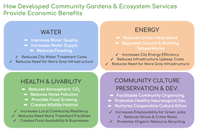Designating Community Gardens as Critical Environmental Areas

Community-stewarded gardens provide significant ecosystem benefits—such as storm water runoff mitigation; urban heat island effect mitigation; air filtration of ambient particulate matter and other noxious pollutants; carbon sequestration; food production; etc. Yet these spaces are often treated as if they’re economically valueless and—by extension—politically invisible. The land that community gardens occupy has too often been derogated as “under-utilized” within the City Planning ULURP regime and, as such, subject to destruction in the name of real estate development.
Designating Community Gardens as Critical Environmental Areas was a policy feasibility research project which explored the potential for increasing the regulatory protections for community gardens. The goal was to establish an ecological basis—using ecological metrics to both quantify and monetize the various ecosystem services realized through the presence and community stewardship of community gardens. Such metrics subsequently served as the basis for community advocacy for designating community gardens/community farms as “Critical Environmental Areas” according to New York State Department of Environment Conservation (DEC), and, ultimately, for having them designated as permanently protected Public Trust areas. Such DEC designation would significantly raise the bar for assessing Environmental Impact of real estate development projects on local communities during the city’s ULURP (Universal Land Use Review Procedure).
With the strategic collaboration of EARTHJUSTICE, the research data from this project helped to inform a legislative bill that calls for facilitating the regulatory designation of community gardens as Critical Environmental Areas. The bill was recently unanimously passed by both the New York State Senate and the New York State Assembly.
